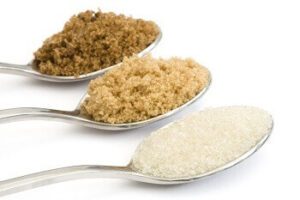Sugar The Sweet Death, Or Is It…
With the holidays just being over, I thought it would be a good time to talk about the types of sugar. It is hard to bypass all the sweets during the holiday season. Even the die-hards have indulged in a piece of pie and a couple of cookies. After all the research, I am not sure good old table sugar is as bad as everyone says, at least not as a single item. Sugar or sucrose is a natural carbohydrate and is found in fruits and vegetables. It may be one of the purest forms of food on your table.

Sugar has been around for a long time. Its mass production in America began in the 1800s with the sugar cane plant, and sugar beets were added to the mix in the 1900s. Before it was mass-produced, only royalty could afford it. Everyone else did without it or used things such as honey that were naturally sweet. There are many types of sugar. Does it matter what type we eat?
The Process Giving Us Granulated White Sugar
Most sugar or sucrose comes from sugar cane, a fibrous tropical grass containing approximately 14% sucrose. The raw sugar is separated from the sugar cane plant by a huge roller that presses the raw sugar out of the plant. Once it is separated. It is sent to another plant where it is clarified by creating a mixture of milk of lime and carbon dioxide to form calcium carbonate.
The calcium carbonate attracts the non-sugar part from the sucrose. This leaves lots of water and sucrose, so they are used in a vacuum process at a low temperature. This protects the sugar from caramelization which creates a rich brown syrup. They then evaporate the syrup further to create thick crystals, then spin it in a centrifuge similar to how our washing machines work and dry it to leave them a very golden raw sugar. When sugar is in this raw phase, it is 96 to 98 % sucrose. In this phase, the sugar is covered with a thin coat of molasses, which is a natural part of the plant. The actual molasses coating contains sugar, water, plant material, and minerals.
Raw Sugar
Raw sugar is further processed to become granulated sugar, brown sugar, and other forms of sugar. They soak the raw sugar in a sugar water solution to remove the molasses. This process creates a batter-like substance referred to as magma. Magma is put into a centrifuge to separate the molasses from the sugar crystals. They then wash the crystals, dissolve them, clarify or filter them to remove molasses. Giving it a clear golden-colored liquid, and finishing it off with a carbon filter, which evaporates some of the water.
No bleach, just a bunch of spinning and filtering. So far, I think we should have stopped at the raw sugar. It seems they remove the molasses to make the granulated sugar and then add back molasses to make it light brown or dark brown sugar. Most of the raw sugar that we get in the grocery store is turbinado sugar, and it is the raw sugar slightly washed, so it still retains some of its natural molasses, which is what I use if and when I eat sugar.
Different Types of Sugar
There are different types of sugars and sugars can be monosaccharides or disaccharides. Monosaccharides are known as simple sugars. Simple sugars consist of fructose (fruit sugar including honey), glucose (also found in different types of fruits including onions and beetroot), and galactose (found in the milk of mammals).
Disaccharides are two monosaccharides joined together. These would include sucrose (glucose and fructose) which is found in sugar cane and sugar beets, lactose (glucose and galactose) found in mammals’ milk, and maltose (two glucose molecules joined together) found in cereals like barley and malt. What we need to understand is that all sugars are broken down by the body into glucose which is used by the body as energy.
Granulated table sugar is pure sucrose, a carbohydrate, which provides energy for the body that contains no fat and no protein. It contains 15 calories per teaspoon and is rated as a medium on the glycemic index.
It is important to understand all food is placed into a category of carbohydrates, proteins, or fats. All carbohydrates contain sugar, so all sugars are considered carbohydrates. The group we classify as carbohydrates is the group the body uses first for energy and converts carbohydrates into glucose. Are you beginning to see why sugar gets so much attention?
Energy and the Body
When we eat something that is either a protein, fat, or carbohydrate we are giving our body energy in the way of food. Calories is what measureFood energy is measured in calories. Proteins and carbohydrates contribute 4 calories per gram, and fats contribute 9 calories per gram. It takes 3,500 calories to gain a pound of fat. You have to decrease your calories by 3,500 to lose a pound of fat.
Carbohydrates are the first source of energy for the body and can be either simple or complex. Simple carbohydrates such as granulated sugar, white flour, white bread, and white rice turn to glucose in the body quicker than complex carbohydrates. Complex carbohydrates such as oatmeal, whole grains, and most fruits (since most fruit contains sugar and fiber) take longer to convert to glucose in the body.
The time it takes for food to turn to glucose in the body is called the Glycemic Index (GI). The glycemic index is based on white bread as the standard. White bread has a glycemic index of 100. Foods with a glycemic index larger than 100 means they convert to glucose quicker than white bread and those with a glycemic index under 100 are slower to convert to glucose. So a teaspoon of granulated table sugar converts to glucose slower than a piece of white bread.
This is largely due to white bread containing sugar and flour (starch)! The problem with processed sugars and carbohydrates such as white bread, donuts, cookies, and cakes is that they do not contribute much more than energy (glucose) to the body. They lack nutrition, which is why our bodies seem to remain hungry and why so many are stressed by eating whole grains, fruits, and vegetables.
Proteins
Proteins gift to the body is generally not as a source of energy. Protein is, however, extremely important because almost every part of our body is made up of protein. Our bodies are constantly building and breaking down, so they are constantly using protein. Proteins contribute amino acids to the body, and amino acids are needed by the body to build strong muscles, create and repair cells, and produce antibodies to fight disease. Remember, your heart and lungs are muscles. The protein that is not converted to amino acids is converted to glucose or glycogen.
Fats
Fats provide some energy to the body (usually as a stored form of energy) as well as providing the body with some padding to insulate our organs and nerves. These fats also provide the body with fatty acids. Remember, fat provides the most calories per gram, twice the amount of calories carbohydrates and proteins do. Even though they are broken down into fatty acids and glucose, it takes the body a lot longer to break them down and while the body is breaking down the fat, the body continues to search for carbohydrates and glycogen to get its energy.
What happens to the protein, fat, and carbohydrates we don’t use right away for energy? Remember, protein is converted to amino acids and glucose. Fat is converted to fatty acids and glucose, and carbohydrates are converted to glucose. Well, all the glucose that is not used is converted to glycogen and stored in our liver and our muscles for further use. The glycogen stored in the liver is used for energy for the body. The glycogen stored in our muscles is used by our muscles. Once our liver and muscles are full of glycogen, our body turns the rest of the glucose into fat!

What Impact Does Table Sugar Have on Our Health
I couldn’t find any studies or evidence that eating regular old table sugar spikes your insulin rate. Not even studies that it causes cancer or obesity or any other illness for that matter other than tooth decay. I did, however, find scientific research showing that most of the sugar substitutes like high fructose corn syrup and the sugars found in many processed foods is the cause for several of these health issues. Think about the various types of sugar you may be consuming.
It appears table sugar is not that bad for you when used in moderation. It is certainly better than a majority of unnatural sweeteners like Nutra Sweet or sugar substitutes like high fructose corn syrup. I feel bad for sugar taking the blame for almost everything. Especially knowing that overeating even healthy foods can result in weight gain.
I think it is more fair to blame these health concerns on our lack of keeping a balanced diet. We are not focusing on eating nutrient-dense foods. We must also be conscious of the calories we are consuming in comparison to the calories we are using. Diets high in processed foods, which are also high in carbohydrates, are not contributing to a healthy weight. It lacks the fuel and nutrients your body needs to function at its optimum. Pay attention to what you are eating. Work on balancing your diet with proteins, fats, and complex carbohydrates found in fruits and vegetables. Also, go for a walk – our bodies are meant to move!
